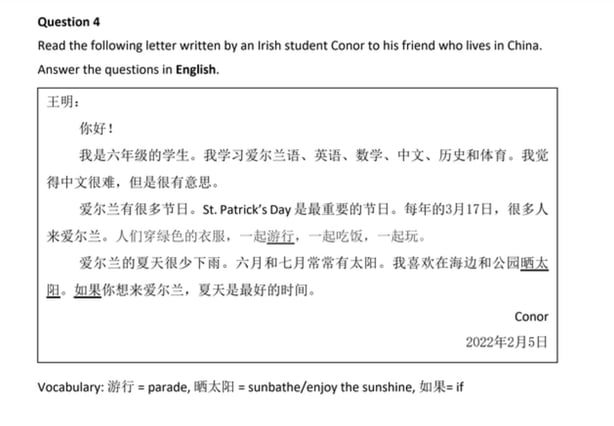Opinion: simplified Chinese dominates how the Chinese language is taught and learned in Ireland, which seems out of step with global trends
By Qi Zhang, DCU and Caitríona Osborne, UCD
The Mandarin Chinese Leaving Certificate exam will take place next Monday. It's the second time that students in Ireland will sit this exam, which was first introduced last year. However, the exclusion of traditional Mandarin Chinese script has already led to heated discussion. Indeed, the salient features of Chinese script have posed significant challenges to Chinese as a foreign language learners, which leads to questions of how to teach and learn the Chinese writing system.
The difference between simplified and traditional Chinese scripts may further complicate Chinese language teaching. The former is the official writing system in mainland China and Singapore, whereas the latter is officially and predominantly used in regions such as Hong Kong, Macau and Taiwan.
The number of Chinese characters increased from about 3,300 in the Qin dynasty (221-206 BCE) to 47,043 in the Qing dynasty (1716 CE). Due to the daunting, labour-intensive nature of learning Chinese characters, the traditional Chinese script went through a simplification process between the 1930s and 1960s, affecting more than 8,000 characters.
From Explore Mode, how Chinese characters exploded
According to Prof Chaofen Sun of Cambridge University, the simplification process mainly involved "the reduction of the number of strokes for the commonly used characters and the number of multiple-graphic forms for a commonly used word". For example, the character for 'head', 頭, was simplified to 头. The number of strokes was reduced from 16 to 5, and the left-right form was simplified to an integral structure.
While the simplified Chinese script contributed to mass literacy in mainland China, there have always been conservative attitudes against this simplification. Hong Kong still has a biliterate and trilingual language policy: both traditional and simplified Chinese are official scripts, and Cantonese, Mandarin and English are official spoken languages. In Taiwan, the traditional Chinese script is maintained, as it is seen as "better connected to Chinese history and culture and therefore constitutes Taiwan’s niche, given the growing global interest in Chinese culture", per Dr Hongying Wang and Yeh-Chung Lu.

While the Leaving Cert exclusively uses simplified Chinese, similar examinations in the UK permit the use of either form of script. For example, Cambridge International AS and A-levels allow candidates to write their answers in either traditional or simplified Chinese, though the exam papers themselves use simplified script. In Pearson Edexcel A-level Chinese, the assessment is available in both traditional and simplified characters, and consequently candidates can choose either form to answer questions.
The dominance of simplified Chinese is evident in the teaching, learning and assessment of Chinese in Ireland, which seems to be out of step with the global trend. The exclusive use of the simplified script for the Leaving Certificate may raise concerns about the equality and sustainability of Chinese language education in Ireland, especially in terms of cultural diversity and the global competitiveness of Irish graduates.
From Chineasy, what are the differences between traditional and simplified Chinese?
While allowing both simplified and traditional Chinese in the exam seems to be the obvious choice, the primary challenge is the availability of resources, including human resources and teaching materials. Recruitment of teachers with competence in both simplified and traditional Chinese scripts would be required.
Research highlights that teachers and examiners from mainland China who grew up using the simplified script appear to employ an analytic approach to processing simplified characters. On the other hand, teachers and examiners from Hong Kong or Taiwan who are accustomed to traditional script tend to holistically process traditional characters, since they provide more information. These different processing skills demonstrate that an expert reader of one script may be a novice reader of the other.
From RTÉ Learn's Exam Diaries in 2022, Ching Pang from Pobalscoil Neasain, Dublin 13 on last year's Mandarin Chinese Leaving Cert paper
In terms of teaching materials, school textbooks play a vital role in the process of cultivating the worldview of young citizens. They are also the core resources for foreign language teaching, especially with a language as difficult as Chinese. Because of the salient features of the Chinese script, authenticity and flexibility are highlighted as two key features of textbooks for Chinese language teaching.
Authentic educational materials can maximise the learner’s exposure to language and cultural context, to help them ultimately be able to perform in the target culture. Flexibility refers to accommodating the uneven development in oral and written skills of beginner learners, and supporting both simplified and traditional scripts.
However, it is not easy to deal with these challenges in order to integrate both writing scripts in the Leaving Certificate, especially with limited resources invested in education in general and specifically in Mandarin Chinese. Although a lack of resources is not a sufficient response for students, it should be noted that these resource issues are preventing government bodies from investigating this matter further. In-depth analysis is badly needed in order to know what resources are available and what needs to be improved, as well as the possible costs of implementing any change. Of course, that is only if the regulatory bodies, academics and general public are open to and welcome such a change.
Dr Qi Zhang is an assistant professor in School of Applied Language and Intercultural Studies at DCU. Dr Caitríona Osborne is an assistant professor in the Irish Institute for Chinese Studies at UCD. Both writers are external advisors for Mandarin Chinese for the Teaching Council.
The views expressed here are those of the author and do not represent or reflect the views of RTÉ

